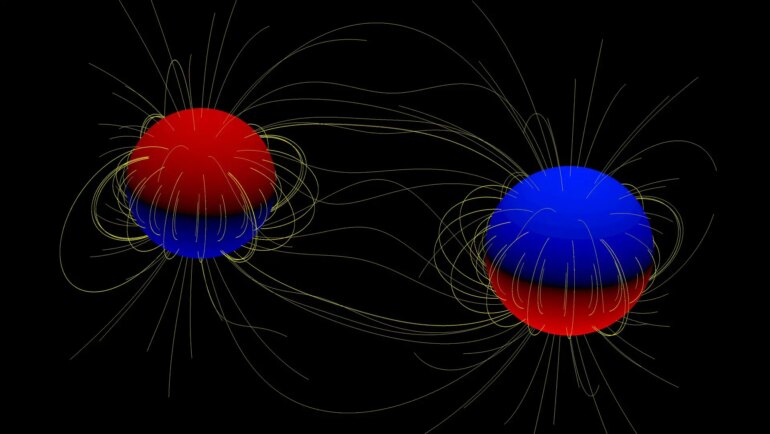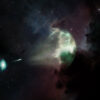Astronomers from the Leibniz Institute for Astrophysics Potsdam (AIP), the European Southern Observatory (ESO), and the MIT Kavli Institute and Department of Physics have discovered that magnetic fields in multiple star systems with at least one giant, hot blue star, are much more common than previously thought by scientists. The results significantly improve the understanding of massive stars and their role as progenitors of supernova explosions. The findings are published in the journal Monthly Notices of the Royal Astronomical Society.
Blue, so-called O-type stars belong to the most massive stars in our universe with masses of more than 18 times that of our sun. While they are rare, they are so hot and luminous that four of the 90 brightest stars visible from Earth belong to this category. They are of extraordinary importance because they drive energetic physical processes that affect the structure of entire galaxies and chemically enrich the region between the stars. Regions of active star formation, like the spiral arms of a galaxy, or in galaxies that are in the process of colliding or merging, are where these stars are typically located. Such massive stars are of particular interest for magnetic studies because they end their evolution explosively as a supernova, leaving behind a compact object, such as a neutron star or a black hole, as a remnant.
Binaries are systems of two gravitationally bound stars that orbit around each other. If both components are O-type stars, this system can become a compact object binary. The final destination of very massive stars is a black hole, while the less massive O-type stars end as neutron stars when they are “dying” as a supernova. The binaries can end as two neutron stars, a neutron star and a black hole, or two black holes. These objects’ orbits degrade via the emission of gravitational waves and are observable by gravitational-wave detectors.
Like the sun, massive stars have stellar winds—an energetic stream of charged particles. These plasma winds respond to magnetic fields and can create a structure, the magnetosphere. All stars and planets with magnetic fields, including the Earth, have a magnetosphere. It protects the Earth from energetic cosmic radiation. The plasma, which can move at thousands of kilometers per second, is subject to extreme centrifugal forces. It has been proposed that this magnetic mechanism can be the reason for the tightly bundled explosion of massive stars, relevant for long-duration gamma-ray bursts, X-ray flashes, and other supernovae features.
While a theoretical explanation for the influence of magnetic fields on supernovae or long-duration gamma-ray bursts was proposed decades ago, since then, only eleven O-type stars have been reported to host magnetic fields. All of them, apart from one star, were single stars or in wide binaries. This was a very puzzling fact, as prior studies had shown that over 90% of O-type stars form in multiple systems, with two or more stars. Indeed, many theorists have been mystified by the rather low number of magnetic fields detected in massive stars, because they could not interpret some of the observed physical characteristics of multiple systems without accounting for the effect of a magnetic field.
To resolve this discrepancy, the authors carried out a magnetic survey, using archival spectropolarimetric observations of stellar systems with at least one O-type component. Spectropolarimetry measures the polarization of the light, which gives information on the existence of a magnetic field in a star. They used data of the high-resolution spectropolarimeters HARPS, installed at the ESO 3.6 m telescope on La Silla/Chile, and ESPaDOnS at the Canada-France-Hawaii telescope on Mauna Kea. To analyze the data, they developed a special, sophisticated procedure for the measurements of the magnetic field.
“To our surprise, the results showed a very high occurrence rate of magnetism in these multiple systems. 22 out of the 36 systems studied have definitely detected magnetic fields, while only three systems did not show any sign of a magnetic field,” explains Dr. Silva Järvinen from AIP’s Stellar Physics and Exoplanets section.
“The large number of systems with magnetic components presents a mystery, but probably indicates that the fact that these stars grew up in binaries plays a defining role in the generation of magnetic fields in massive stars through interaction between the system components, such as mass transfer between two of the stars, or even a merging event of two stars. This work is also the first ever observational confirmation of the previously suggested theoretical scenario for how a star’s magnetic field affects its death, letting it explode faster and more energetic,” says Dr. Swetlana Hubrig.
More information:
S Hubrig et al, Are magnetic fields universal in O-type multiple systems?, Monthly Notices of the Royal Astronomical Society (2023). DOI: 10.1093/mnras/stad730
Provided by
Leibniz Institute for Astrophysics Potsdam
Citation:
Magnetic fields in multiple star systems with at least one giant, hot blue star are more common than previously thought (2023, March 28)



